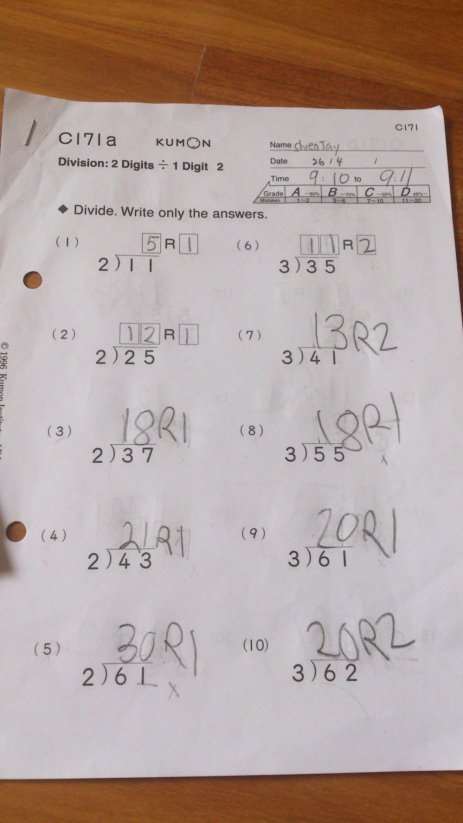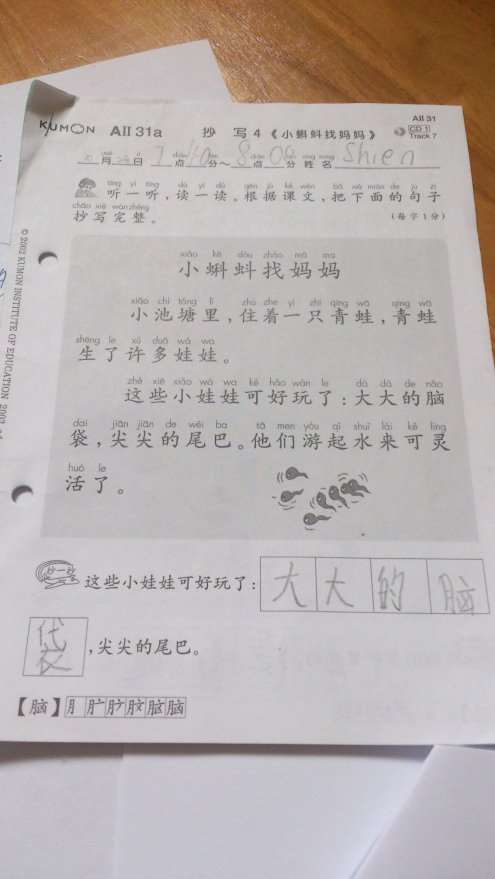Observation of Child with ADHD
| ✅ Paper Type: Free Essay | ✅ Subject: Education |
| ✅ Wordcount: 1349 words | ✅ Published: 16 Jul 2018 |
Child’s Particulars:
- Full Name of Child: Eileen Tay Yi Ling (Pseudonym)
- Chronological Are: 6 Years, 1 Month (From Date of Collection of Background Information)
- Gender: Female
- Race: Chinese
- Current Grade (Standard) in School: Kindergarten 2
Background Information:
Eileen (pseudonym) lives with her family, consisting of her father and mother, her 23 year-old step-brother and a live-in domestic helper. According to the domestic helper, she appears to be closer to both parents than her brother; with she (Eileen) agreeing that she speaks to the parents more than she speaks to her brother.
The family of 5 (including the stay-in domestic helper) stays in 3-bedroom condominium at South-Eastern Singapore. She first started going to an early education facility at the age of 3, and is currently enrolled in 3 early education centres (Kumon, The Learning Lab, and EtonHouse), for enrichment classes and kindergarten.
Based on the information given by her mother, Eileen enjoys going for classes and is on good terms with her teachers. She also expresses interest in Mathematics, though she (Eileen) has the impression that she is weaker in that very subject itself. Annexe A, which is done approximately 2 weeks before, which shows her mathematics worksheet being done with a perfect score, a point which is consistent with the other worksheets shown during the data collection session.
In the areas of language and literacy, Eileen uses mainly English when communicating with her parents, peers and relatives, although she is also generally proficient in her Mother Tongue (Mandarin), which is seen when in the worksheet that she completed (Annexe B) and what was seen when she is reading her storybooks. Eileen also attempts to speak like her parents when engaging in conversation. Eileen is seen to have her strengths in language and literacy, as she is conversant in simple English and is able to provide simple fact-based answers about herself, like where she study, and her family information. Based on the developmental milestones by Chant (2013), Eileen has met the language and literacy developmental milestones of a 5-6 year old.
Eileen’s socio-emotional development appear to be meeting the developmental milestones of her age group, as her parents claim that she is sociable, and that ‘although sometimes got conflict before, but after a while, they are back as friends again (sic)’. In Kumon, she is closer to 3 of her friends whom she has been in the same class for over 18 months (1.5 academic years). Annexe D shows the art that one of her friends did for Eileen’s 5th birthday a year ago. Also, Eileen has her own bedroom, and is able to make her own bed in the morning, after waking up, thereby meeting the socio-emotional milestone of being more independent and in charge of his/her behaviour (Child and Youth Health, 2010).
Eileen’s mother also shared that she (Eileen) can accurately give the birthdates of some of her relatives that she is more familiar with, if given their names, although if she is given the birthdates, she may not be able to state whose birthday that is. Her inability to do so is in line with the child’s level of cognitive development, as Parke and Gauvain (2009) stated that the “inability to reverse a series of mental steps is evident in many other responses of the child between 2 and 6 years old”. She also has an attention span of approximately 10-15 minutes, although her attention span may be extended if she is engaged in something of her interest, and if Eileen was engaged in playing with toys of her particular interest, she would get “very hooked” onto it and that her parents experienced difficulty in getting her to change focus to another activity or task. This is not part of the developmental norms that Schmitt (2012) mentioned, whereby a typically developing child’s attention span should be 3-5 minutes of the child’s age, which means that for Eileen, she should be able to have an attention span of approximately 18-30 minutes.
Data Gathering Plan:
|
Technique One: Conducting an interview-based checklist adapted from Hill Checklist for Attention Deficit and Related Disorders |
|
Description of Technique One: The original Hill Checklist for Attention Deficit and Related Disorders is meant for teachers to help Neurotherapy in evaluating the child in question on if he/she has Attention Deficit or other related disorders. The first section focuses more on Attention Deficit, and utilises a Likert Scale of 0-5, and requires the educator to rank the child’s behaviours based on the characteristic being ‘not present’ (0) to ‘very severe’ (5). Only the first section of the checklist will be used, and it will be implemented through interviewing Eileen’s mother. In addition, she will be asked to elaborate more on each of the items, by explaining and providing examples and descriptions of what Eileen does. I will be noting down the response of Eileen’s mother, and a voice-recording will be done for later reference. |
|
Rationale of Technique One: Based on the background information collected, Eileen is seen to be performing well in most areas of development. However, her attention span of 10 to 15 minutes, according to the background information given by her mother, is lower that the age-appropriate developmental norm of Schmitt’s (2012) age-to-attention span ratio of 3-5 times the child’s age. Also, as Eileen’s mother also mentioned that Eileen tended to be “very hooked” when doing an activity of her interest. This appearance of the lack of focus, while parents having trouble getting the child to divert his/her attention from what interests them (Smith and Segal, 2012) raises a possible risk of the child having Attention Deficit Disorder (ADD). By interviewing Eileen’s mother, and understanding more about Eileen’s behaviour, it will give a better insight into if she is in fact at risk of ADD. |
|
Technique Two: Conducting an Observation as a supplement to the interview-based checklist (Technique One) |
|
Description of Technique Two: At least 2 observation records will be conducted, one running record, and another running record. These observation records will be done on two separate occasions, with a minimum of 3 days in-between each observation session. The observation records will focus on Eileen’s attention span when she is doing her work, or at play. Environmental factors like the presence of noise and side activities, like people walking pass or the programmes airing on television, will be noted down. |
|
Rationale of Technique Two: As Technique One only provides further information given by Eileen’s parents, the full picture of Eileen’s apparent lack of attention span may not be clear. Therefore, by observing Eileen, and her environment, while she is on her daily routines like having a meal, doing her work or watching television programmes, will provide a ‘second’ picture of the possible causes of the short attention span that she has, since observing a child is useful in isolating the root of the problem, inclusive of the environment surrounding the child (LD Online, 2000). An analysis of the observations done will also conducted to have a better insight into the rationale of her actions. This, together with Technique One, a clearer picture of where Eileen’s development in terms of attention will be seen, as well as if she is possibly at-risk of having ADD. |
References:
Child and Your Health. (2010). Child development: 5-6 year old children. Retrieved from http://raisingchildren.net.au/articles/child_development_5-6_years_cyh.html/context/511
Chant, R. (2013). Developmental milestones of 5-6 year olds. Retrieved from http://starskills.net/blog/developmental-milestones/developmental-milestones-of-5-6-year-olds/
Hill, Robert W. (n.d.) Hill checklist for attention deficit and related disorders. Retrieved from http://www.neurotherapydfw.com/pdf/ChildForm-Teacher26-23-08.pdf
LD Online. (2000). Early Intervention – Observation of an individual child. Retrieved from http://www.ldonline.org/article/6048/
Parke, R. D. and Gauvain, M. (2009). Child psychology: A contemporary viewpoint. New York: McGraw-Hill
Schmitt, B. D. (2010). Attention deficit/hyperactivity disorder (ADHD): How to help your child. Retrieved from http://www.cpnonline.org/CRS/CRS/pa_battentn_hhg.htm
Smith, M. and Segal, R. (2010) ADD/ADHD in children. Retrieved from http://www.helpguide.org/mental/adhd_add_signs_symptoms.htm
Annexes:
Annexe A: Mathematics

Annexe B: Language (Mandarin)

Annexe C: Socio-emotional

Cite This Work
To export a reference to this article please select a referencing stye below:
Related Services
View allDMCA / Removal Request
If you are the original writer of this essay and no longer wish to have your work published on UKEssays.com then please click the following link to email our support team:
Request essay removal


